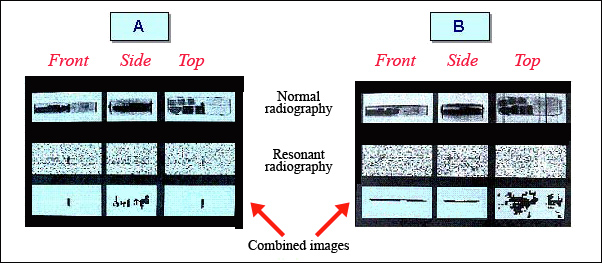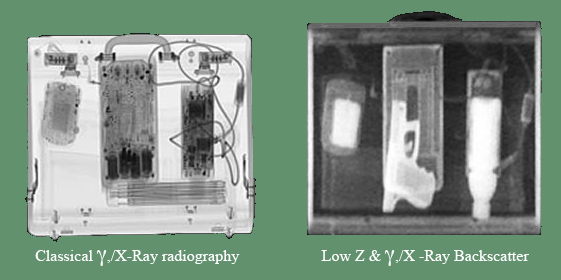Radioactivity and radiations against traffickers and terrorism
Many customs or police installations are now equipped with sophisticated facilities able of taking radiography of an entire car or lorry. These radiographies use gamma rays which are more penetrative than the more commonly used X-rays. Complex calculations reconsruct in space the cargo of a lorry, car or container in order to identify the suspected areas. For instance, customs have been able to detect drugs concealed in a fake part of the engine and to arrest the driver.

Searching for explosives in suitcases
On the left (A), three gamma rays radiographies of a suitcase : Top, normal radiography where the darker parts indicate denser areas; Middle « resonance » radiography, where darker areas represent higher density of nitrogen ; Bottom, the combination of normal and resonant radiographiies reveals a stick of semtex explosive. On the right (B), the radiographies of a second suitcase This time the explosive is hidden in a double-bottom lid.
© DR
Nuclear techniques help improve the search for explosives in airports. Passenger luggage undergoes radiography by gamma rays whose energy – 9,17 MeV – is exactly equal to the one required to excitate a nitrogen nucleus, an element present in strong concentrations in explosives. These nuclei lose their excess energy in emitting gamma rays. Two scans are made : one standard radiography and one “resonating” radiography which measures how many photons are absorbed and re-emitted by the nitrogen contained in the inspected object. The standard radiography is sensitive to dense matter, the “resonating” radiography to nitrogen products. The comparison of the two images allows the precise location of the suspected substances.
Italian researchers are developing detectors for explosives. Used in countries devastated by war, they could help to clear the minefields. These techniques use neutrons because of their depth of penetration. By penetrating in the earth, neutrons interact with nitrogen compounds of carbon and hydrogen which make up the usual explosives. Nitrogen nuclei which have captured these neutrons release energy in excess by emitting a gamma ray with a characteristic energy. In detecting and measuring the energy of these gamma it is possible to go back to the chemical nature of the items present in the ground and thereby deduce the presence of explosive substances. Researches are also made to develop mobile sources of neutrons.

Gun detection in a briefcase
Suitcase conventional radiography of this briefcase gives no indication of the nature of the objects it contains. On the contrary, a low Z backscatter radiography of the same briefcase, brings up the outline of an handgun in its holster.
© DR
Police and customs uses techniques physics techniques to fight against drugs rafficking, weapons smugglers and terrorism. They resort to gamma rays produced by small accelerators, ultra-sensitive detectors, ans image reconstructions techniques developed by physicists in their experiments.
Organic materials rich in atoms with a low atomic number Z do not show up well on traditional X ray (or gamma ray) images. This is also the case with explosive materials which contains low atomic number (low Z) elements such as carbon, oxygen, hydrogen, and nitrogen.
American engineers working in the fields of defence and counter-terrorism, have succeeded in producing images highlighting organic material by directing a sweeping beam of X or gamma rays at the object under examination. They measure and plot the intensity of scattered backward X or gamma rays as a function of the beam position. The dackscatter signals are particularly strong whenever the incident rays interact with explosives, plastics, and other biological items, which contain low Z materials. Even inorganic objects, such as metals, are given shape and form in these ackscatter images, making them easier to interpret than with classical radiographies.